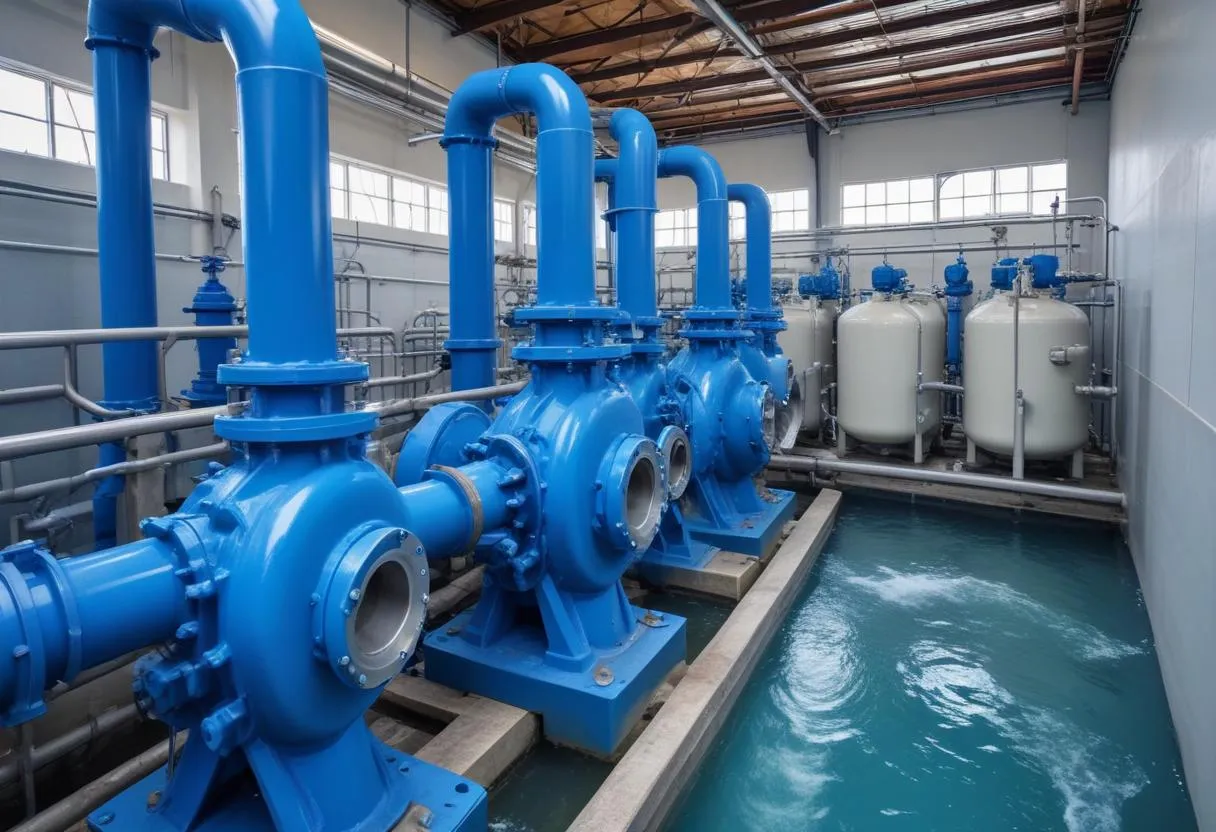 Centrifugal pumps operate by harnessing the physical principle called centrifugal force. This force is experienced as an outward pushing force felt by objects moving in a circular path. In the context of the pumps, it occurs as the impeller, which is a rotating component, pushes water or other fluids away from its center, or rotation axis, due to the force generated by its rapid spinning motion.
Centrifugal pumps operate by harnessing the physical principle called centrifugal force. This force is experienced as an outward pushing force felt by objects moving in a circular path. In the context of the pumps, it occurs as the impeller, which is a rotating component, pushes water or other fluids away from its center, or rotation axis, due to the force generated by its rapid spinning motion.
To explain this concept thoroughly, imagine adding water to a bucket and swinging it around in a circle. As you spin the bucket faster, the water presses against the bottom of the bucket despite being upside down at the peak of each swing. This happens because the water is subjected to centrifugal force, pushing it outwards and keeping it from falling out of the bucket. In centrifugal pumps, this scenario helps move fluid from the entry point at the center of the impeller to the outer edges before it exits through a discharge point.
| Component | Function |
|---|---|
| Impeller | Rotates to add energy to the fluid through centrifugal force |
| Casing | Contains the fluid and helps to direct its flow out of the pump |
| Suction Pipe | Channels fluid into the pump |
| Discharge Pipe | Channels fluid out of the pump after energy has been added |
The impeller’s design and rotational speed are critical factors in determining the overall efficiency and effectiveness of the pump. As the impeller rotates, the fluid enters the pump axially, is accelerated radially outwardly into the pump casing, and exits through the discharge port. The energy transfer from the impeller to the fluid increases the fluid’s velocity and pressure.
The operation of a centrifugal pump can be detailed through the following steps in sequence:
- Fluid enters the pump through the suction inlet located at the center of the impeller.
- The rotational motion of the impeller imparts velocity to the fluid as it moves outward along the impeller blades.
- The fluid is expelled into the pump casing, where the velocity is converted into high pressure due to the volute shape of the casing which confines the fluid.
- Finally, the high-pressure fluid exits the pump through the discharge outlet effectively moving the fluid to new locations or into new systems.
Understanding these details helps to illustrate not only how centrifugal pumps work but why their design is so prevalent in various industrial and engineering applications. This understanding also sets the groundwork for exploring more complex pump designs and configurations tailored for specific applications and performance requirements.
Components and design of centrifugal pumps
When discussing the components and design of centrifugal pumps, it is important to recognize that each part plays a crucial role in the overall functioning and effectiveness of the pump. The main components of a typical centrifugal pump include the impeller, casing, shaft, bearings, seals, and the suction and discharge ports. Below, we explore the design features and functions of each component in detail.
Impeller: The impeller is essentially the heart of the centrifugal pump. It consists of a series of curved vanes, usually made of metal or plastic, fitted onto a central hub. The impeller can be classified based on its mechanical design as either an open, semi-open, or closed type. Each design has its distinct advantages and is chosen based on the type of fluid being moved and the specific requirements of the pumping system.
| Type of Impeller | Features | Best Used For |
|---|---|---|
| Open | Vaned structure without a crown and back | Handling solids and viscous fluids |
| Semi-open | Vaned structure with either a crown or a back | Fluids with smaller solids |
| Closed | Vaned structure enclosed between two discs | Clear liquids and high-pressure applications |
Casing: Surrounding the impeller is the casing, which serves to contain the fluid and direct its flow. The casing shape is often volute, meaning it resembles a snail shell, which helps to gradually convert the kinetic energy of the fluid into pressure energy.
Shaft: The shaft connects the impeller to the motor that drives it. It needs to be sufficiently strong to transmit the torque during operation while resisting bending.
Bearings: Bearings support the shaft, enabling it to rotate smoothly within the pump casing. Proper bearing selection and maintenance are crucial for ensuring prolonged pump lifespan and operational efficiency.
Seals: Centrifugal pumps typically use either stuffing boxes or mechanical seals to prevent the fluid handled from leaking along the shaft. Mechanical seals are more effective and have a longer service life, making them a preferred choice in most modern pumping applications.
Suction and Discharge Ports: These are the pathways for fluid entering and leaving the pump. The suction port connects to the pump inlet, which is positioned to be close to the center of the impeller, while the discharge port sends the fluid out into the system or pipeline.
The overall design of centrifugal pumps is heavily influenced by the specific applications they are meant for, which include handling corrosive substances, high-temperature fluids, and materials with varying viscosity levels. Here are additional design considerations:
- Material Selection: Depending on the fluid characteristics, different materials such as cast iron, stainless steel, or even high-grade plastics may be used to enhance durability and performance.
- Corrosion and Abrasion Resistance: Special coatings or treatments may be applied to combat the effects of corrosive fluids or abrasive materials.
- Efficiency Optimization: The geometry of the impeller and casing is designed to maximize fluid flow while minimizing energy consumption.
In summary, a centrifugal pump’s design is carefully engineered to meet specific pumping demands, with each component integrated to ensure optimal function, efficiency, and longevity of service. Understanding these components and their individual roles can aid in troubleshooting, maintenance, and selection of the right pump for any application.
Common applications and performance considerations
 Centrifugal pumps are remarkably versatile and can be found in various industries due to their ability to efficiently handle different types of fluids under a broad range of flow rates and pressures. Recognizing the common applications of these pumps is essential for understanding their performance considerations in practical scenarios.
Centrifugal pumps are remarkably versatile and can be found in various industries due to their ability to efficiently handle different types of fluids under a broad range of flow rates and pressures. Recognizing the common applications of these pumps is essential for understanding their performance considerations in practical scenarios.
Water Supply and Treatment: One of the most widespread uses of centrifugal pumps is in water supply systems, including municipal water treatment plants and irrigation systems. These pumps facilitate the movement of water from wells, rivers, or reservoirs to treatment facilities and then on to consumption points. In sewage treatment plants, centrifugal pumps are used for pumping the treated water to a release point.
Chemical and Process Industries: These sectors utilize centrifugal pumps for transferring various chemical liquids, which may be corrosive, viscous, or at high temperatures. The design of the pump in these applications is critical to handle the chemical properties and ensure safe, efficient operation. For instance, stainless steel or other corrosion-resistant materials are chosen for the impeller and casing.
HVAC (Heating, Ventilation, and Air Conditioning): In the HVAC industry, centrifugal pumps facilitate the circulation of heat transfer fluids across heating and cooling systems. This includes the transfer of hot water and chillers in large office buildings, industrial sites, and residential complexes.
Oil & Gas Industry: Centrifugal pumps are integral to offshore and onshore operations, including tasks such as loading and unloading tankers, transferring fuel surrogates, and injecting water into reservoirs to enhance oil recovery.
Food and Beverage: In food processing and beverage industries, hygiene is paramount. Centrifugal pumps used here are specifically designed with easy cleanability in mind, often featuring sanitary materials and smooth surfaces.
| Industry | Typical Fluids Handled | Key Performance Considerations |
|---|---|---|
| Water Supply and Treatment | Water, sewage | Efficiency, reliability |
| Chemical and Process Industries | Acids, solvents | Chemical resistance, safety |
| HVAC | Heat transfer fluids | Energy efficiency, operational consistency |
| Oil & Gas | Crude oil, water, chemical additives | Robustness, explosion-proofing |
| Food and Beverage | Liquids requiring hygienic handling | Sanitation, ease of cleaning |
In terms of performance considerations, several factors must be kept in mind when selecting and operating a centrifugal pump:
- Flow Rate: The required flow rate is a crucial factor as it determines the pump size and specifications. Pumps must be capable of handling the maximum expected flow while maintaining efficiency.
- Head: Also known as the pressure created by the pump, this is dictated by the height of fluid transfer and resistance encountered due to friction or changes in flow direction.
- Net Positive Suction Head (NPSH): This parameter helps avoid cavitation, ensuring that the pump operates below the fluid’s vapor pressure.
- Power Consumption: Understanding the energy requirements of a pump can significantly influence its operational cost. Selection should focus on high-efficiency models that can handle the required tasks with minimum power.
- Maintenance Needs: Ease of maintenance ensures longer service intervals and reliability. It is crucial for pumps in critical applications where downtime can lead to significant costs or safety concerns.
Therefore, the selection of a centrifugal pump and its design must be approached with careful consideration of the intended application, the nature of the fluid being moved, environmental conditions, and efficiency requirements. These factors collectively determine the potential performance of the pump and its suitability in a specific industrial context.